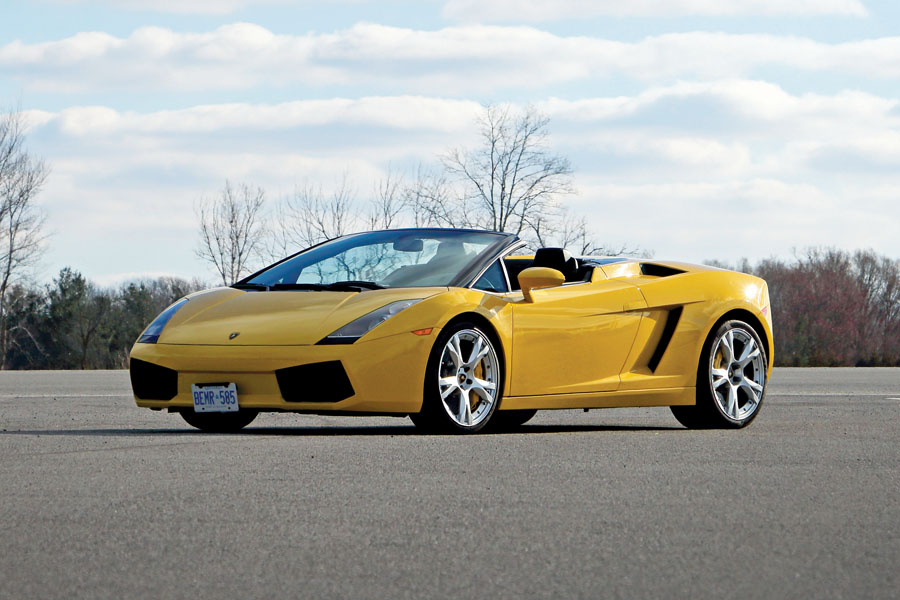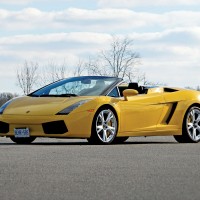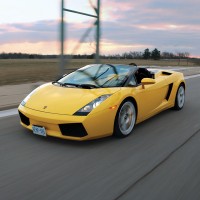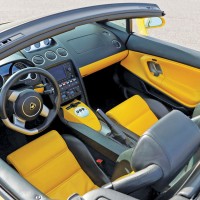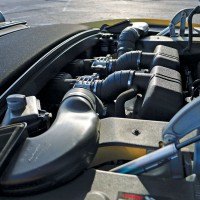SCM Analysis
Detailing
| Vehicle: | 2007 Lamborghini Gallardo Spyder |
| Years Produced: | 2003–13 |
| Number Produced: | 14,022 |
| Original List Price: | $200,000 |
| SCM Valuation: | Median to date, $121,000; high sale, $127,500 |
| Tune Up Cost: | $800 |
| Distributor Caps: | N/A |
| Club Info: | Lamborghini Club America |
| Website: | http://www.lamborghiniclubamerica.com |
| Alternatives: | 2011–15 Ferrari 458 Spider, 2010–12 Audi R8 Spyder, 2011–14 McLaren 12C |
| Investment Grade: | D |
This car, Lot 205, sold for $105,600, including buyer’s premium, at Auctions America’s Fort Lauderdale, FL, auction on April 1, 2016.
Interest in exotic cars has never been higher than it is today. In fact, we are living the glory years of the supercar right now. One benefit of living in any golden age is that today’s (and tomorrow’s) collectors will have the first opportunities to acquire the best cars at the most attractive prices.
In the past, exotic cars were considered exotic in large part because they were vanishingly rare. Ferrari didn’t hit triple-digit annual production until 1957, and the company didn’t build more than 1,000 cars per year until 1971. In that era, Enzo Ferrari was still personally signing each car’s warranty card. In contrast, current Ferrari production is around 7,000 cars per year, with a goal of 9,000 units annually by 2019. That’s still boutique auto making, but a great difference from a factory that rolls out a couple of cars per week.
Lamborghini gets cranking
With Lamborghini, the numbers are even more striking. The Lamborghini Silhouette was made from 1976 to 1979, and a total of 54 units were built in that period. The Silhouette was succeeded by the Jalpa, of which just 410 were made from 1981 to 1988. The Gallardo, built from 2003 to 2013, totaled 14,022 units, of which 13,992 were road-going models. That’s three times as many cars as the second-most-common Lamborghini, the Murcielago, at 4,099 cars produced over 10 years from 2001 to 2010.
So what happened? Primarily, Lamborghini was purchased by VW/Audi in 1998, giving the Italian supercar manufacturer the backing to raise production levels — and access to technology and engineering resources they hadn’t had before.
The dramatic rise in Gallardo production will be critical to future collectibility of the model (and its successors) because it means that the normal market rules of mass-produced collector cars will apply — rather than the unicorn market of the older exotics.
The rules of depreciation and appreciation
Conventionally, cars hit their lowest values at about 15 to 20 years of age, before they disappear into junkyards or start to rise again as collectibles. The first Gallardos are approaching the 15-year mark, and while it is certain that they will eventually rise again, the question is how much and when. Is a modern exotic a good investment as well as a fun ride and a great conversation piece?
Because of their initial purchase price and desirability, no Lamborghini is going to go through any period of middle-aged neglect like a Pontiac Trans Am or Chevrolet Corvette. Exotics will always be garaged and babied, with minimal miles on the clock.
However, the sheer number of cars available will help to keep prices under control indefinitely. Attrition in numbers will come exclusively from collision damage — not rust.
Still riding the downward curve
Looking at this sale, it’s clear that prices are still falling. The 2007 Gallardo Spyder had an original sticker price right around $200,000, depending on options. Lamborghini made 1,015 Gallardo Spyders that year, and an additional 936 coupes. The years 2006 to 2008 were the largest production runs of the Gallardo line, at about 2,000 cars per year. So a sale price of $105,600 is at par — about half the original value for a 9-year-old car.
Like most exotics, this car shows extremely low mileage and great care taken, but as always, a buyer should be sure to perform due diligence.
In the text of the catalog description, the car is variously described as having 13,000, 1,300 and 7,361 miles on the odometer. With an exotic, that makes a difference. Also, buyers should note that the 2007 Gallardo came with the 5.0-liter V10 at 520 metric horsepower, not the 5.2-liter, which debuted in 2008, at 560 metric horsepower. The auction listing shows the correct horsepower — but incorrect displacement.
In short, there’s nothing wrong with this car, but the sale price was not as high as comparable sales from just a few years ago.
With dozens of sub-models and special editions out there, the value of any particular Gallardo is still unique.
But the trend still seems downward for the moment, and that’s good news for buyers — especially younger collectors who grew up with Lamborghini posters on the wall and are now hunting down the real deal. There will be plenty of quality stock to choose from over the next decade, and collectors can be choosy and economical in their bids. If you miss out on one Gallardo, there’s sure to be another one crossing the block soon. ♦
(Introductory description courtesy of Auctions America.)
